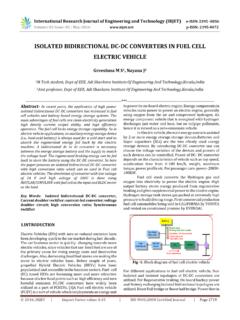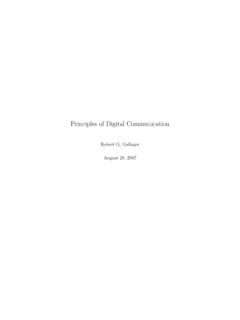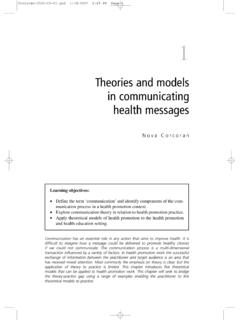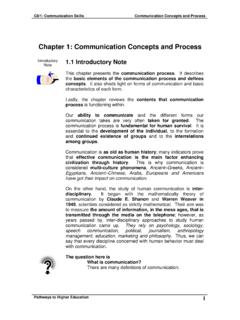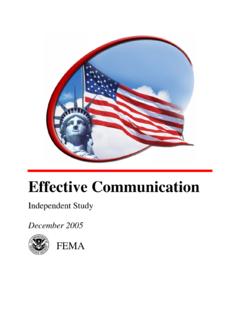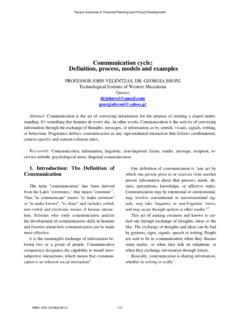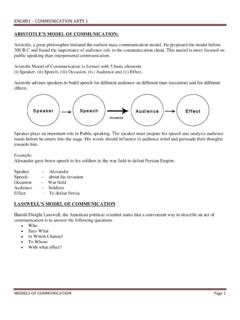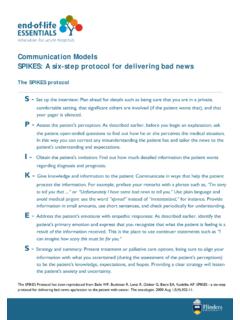Transcription of PROPAGATION MODELS FOR WIRELESS COMMUNICATION …
1 International Research Journal of Engineering and Technology (IRJET) e-ISSN: 2395-0056 Volume: 05 Issue: 01 | Jan-2018 p-ISSN: 2395-0072 2018, IRJET | Impact Factor value: | ISO 9001:2008 Certified Journal | Page 237 PROPAGATION MODELS FOR WIRELESS COMMUNICATION SYSTEM Zahera Naseem1, Iram Nausheen2, Zahwa Mirza3 1,3 Student, Year, Dept. of Electronics & COMMUNICATION Engineering, Anjuman College of Engineering & Technology, Maharashtra, India. 2 Assistant Professor, Dept. of Electronics & COMMUNICATION Engineering, Anjuman College of Engineering & Technology, Maharashtra, India.
2 ---------------------------------------- -----------------------------**--------- ---------------------------------------- --------------------Abstract This paper gives an overview of the PROPAGATION MODELS in WIRELESS COMMUNICATION systems. WIRELESS COMMUNICATION system uses several physical media, ranging from sound to radio to light. These characteristics are affected by the physical environment between the transmitter and receiver. WIRELESS COMMUNICATION system suffers from various unwanted effects of fading which may be caused due to multipath PROPAGATION , path loss, shadowing, Doppler spread and co-channel interference.
3 There are various signal PROPAGATION ranges in WIRELESS COMMUNICATION channels. Key Words: Characteristics of WIRELESS COMMUNICATION system, path loss, fading, interference, types of PROPAGATION MODELS -outdoor & indoor PROPAGATION model . 1. INTRODUCTION The WIRELESS COMMUNICATION system posses several challenges for the reliable and a high speed COMMUNICATION . It is not receptive of noise channel and other channel hindrance, but these obstacle changes with time in unforeseeable ways due to user movement. We will characterize in detail the variation in the received signal power over the distance due to path loss and shadowing.
4 Path loss MODELS describe the signal attenuation between a transmitter and receiver antenna as a function of PROPAGATION distance and other parameters which is caused by the dissipation of the power radiated by the transmitter as well as effects of the PROPAGATION channel. Shadowing is caused by obstruction between the transmitter and the receiver that attenuate the signal power through absorption, reflection, scattering, and diffraction. A very important practical issue is to test and validate the ability of the smart antenna array to meet performance requirements. For this purpose, a channel model is needed to take into account the temporal and spatial characteristics of radio PROPAGATION .
5 2. WIRELESS CHANNEL The WIRELESS signal proliferate in space, based on the rule of physics. An electromagnetic Radio Frequency (RF) signal which proceed in a medium suffers an attenuation (path loss) based on the nature of the medium. In addition, the signal experiences objects and gets reflected, refracted, diffracted, and scattered. The cumulative effect results in the signal getting absorbed, signal travel across multiple paths, signal s frequency being shifted due to relative motion between the source and objects (Doppler Effect), thus are getting modified in a sufficient way. It is clear that the radio frequency signal is a space-time-frequency signal.
6 3. CHARACTERISTICS OF WIRELESS CHANNEL The main characteristics of WIRELESS COMMUNICATION channel are as follows: 1. Path loss 2. Fading and shadowing 3. Interference 4. Doppler shift Path loss Path loss can be expressed as the ratio of power of transmitted signal to the power of the same signal received by the receiver on a given path. It is a function of the PROPAGATION distance. Estimation of path loss is very important for designing and deploying WIRELESS COMMUNICATION networks. Path loss depends on the number of factors such as the radio frequency used and the nature of the terrain. The free space PROPAGATION model is the simplest path loss model in which there is a direct-path signal between the transmitter and the receiver with no atmosphere attenuation or multipath components.
7 In this model , the relationship between the transmitted power Pt and the received power Pr is given by Where, d is the distance between the transmitter and receiver is the wavelength of the signal It is actually experienced that the signal reaches the receiver through the multiple paths. The two path model struggles to capture this phenomenon. The model assumes that the Two-way model also called as two path MODELS is widely used path loss model . The free space model give a detail amount of above assumes that there is only one single path from the transmitter to the receiver. Gt is the transmitter antenna gain Gr is.
8 The receiver antenna gain International Research Journal of Engineering and Technology (IRJET) e-ISSN: 2395-0056 Volume: 05 Issue: 01 | Jan-2018 p-ISSN: 2395-0072 2018, IRJET | Impact Factor value: | ISO 9001:2008 Certified Journal | Page 238 signal reaches the receiver through two paths, one a line-of-sight and the other the path through which the reflected wave is received. According to the two-path model , the power which is received is given by Where, Pt is the transmitted power Gt represent the antenna gain at the transmitter Gr represent the antenna gain at the receiver d is the distance between the transmitter and receiver ht is the height of the transmitter hr are the height of the receiver Fading Fading mentions the fluctuations in strength of the signal when the signal is received at the receiver.
9 Fading can be classified into two types Fast fading/small scale fading and Slow fading/large scale fading Fast fading refers to the swift fluctuations in the amplitude, phase or multipath delays of the received signal, due to the interference between the multiple versions of the same transmitted signal arriving at the receiver at slightly different time interval. The time between the reception of the first version of the signal and the last echoed signal can be expressed as delay spread. The multipath PROPAGATION of the transmitted signal, which causes fast fading, is because of the three PROPAGATION mechanisms, namely Reflection Diffraction Scattering The multiple signal paths may sometimes add constructively or sometimes destructively at the receiver causing a variation in the received signal s power level.
10 The received single envelope of a fast fading signal is said to follow a Rayleigh distribution to see if there is no line-of-sight path between the transmitter and the receiver. Slow Fading The name Slow Fading itself indicates that the signal fades away slowly. The features of slow fading are as given below. Slow fading occurs when objects that partially absorb the transmission lie between the transmitter and the receiver. Slow fading is so called because the duration of the fade may last for multiple seconds or minutes. When the receiver is inside a building and the radio wave passes through the walls of a building slow fading occurs.







